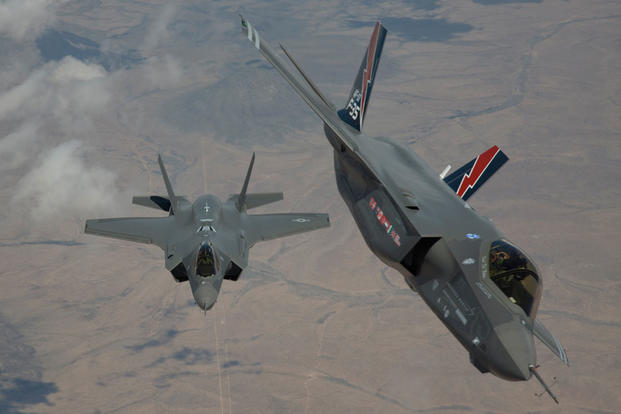Two years after being a no-show at major air shows in England, the F-35 Joint Strike Fighter is once again on the event schedule and gearing up to make its long-awaited international debut.
Gen. Frank Gorenc, commander of U.S. Air Forces in Europe, says the plane's presence at the Royal International Air Tattoo from July 8-10 in Gloucestershire and at the Farnborough International Air Show from July 11-17 outside London will show the partner countries that the stealthy fifth-generation fighter jet "is real."
"What it's going to do for the European allies is reinforce the idea that we're talking about a real piece of equipment," Gorenc said during a breakfast with defense reporters on Tuesday in Washington, D.C.
"We talk about a lot of these platforms in concept," he added. "To actually see it, I think, is an important step in the procurement of that airplane and a reinforcement that what we have is real."
Britain wants to buy nearly 140 of the planes, representing the largest planned international F-35 order.
It's one of eight countries that have committed to help develop the F-35, including the U.K., Italy, the Netherlands, Turkey, Canada, Australia, Denmark and Norway. Also, Israel, Japan and South Korea plan to buy production models of the aircraft.
The Joint Strike Fighter program is the Pentagon's most expensive acquisition effort and now estimated to cost $379 billion for a total of 2,457 aircraft and engines.
The U.S. military has already logged thousands of flying hours in the Lockheed Martin Corp.-made aircraft, known as the Lighting II, working through problems and making them ready for initial operational capability, Gorenc said.
"For us, it is real," he said.
The F-35 missed the 2014 shows in the United Kingdom after an engine in a U.S. Air Force F-35A model caught fire a month earlier during a takeoff at Eglin Air Force Base, Florida. The fleet was subsequently grounded for several weeks.
But even when the grounding was lifted, U.S. military officials continued restrictions on the four jump-jet variants that were supposed to make the trip to Royal Air Force Base Fairford and Farnborough. The four included three U.S. Marine Corps planes and one Royal Air Force F-35B.
"Air shows are all about showing confidence in the product," Richard Aboulafia, a vice president at Teal Group, a consulting company in Fairfax, Virginia, said in 2014 after the Pentagon ordered the grounding because of the engine fire. "And frankly, confidence has been in short supply with the F-35."
The no-show created more drag on an aircraft that has been plagued by delays, cost overruns and technical glitches through development.
Jeff Babione, Lockheed Martin's program manager for the F-35 program, told reporters last month that the cost of the F-35A – the Air Force version of the plane – is expected to drop from nearly $100 million each to about $85 million by 2019 because of efficiencies and cost-cutting manufacturing technologies.
The B and C variants designed for the Marine Corps and Navy, which are heavier and purchased in smaller quantities, are not included in the 2019 goal, he said.
A successful showing of capabilities at Farnborough could boost European confidence in the plane, according to Gorenc.
"I think the effect of seeing it, understanding it, of encouraging more conversation [about] it, of addressing all the things we're doing -- trying to get the price down, increase the capability, trying to help everybody understand the logistics concept – is a fundamental step in the development of an aircraft like the F-35," he said.
The U.S. Marine Corps is considering demonstrating an F-35B vertical landing during RIAT, Defense News reported last month. Like the AV-8B Harrier, the jump-jet variant of the F-35 is designed to fly like a plane and land like a helicopter.
-- Bryant Jordan can be reached at Bryant.jordan@military.com. Follow him on Twitter at @BryantJordan.
Related Video:
Bullet Points: F35 Lightning II




























